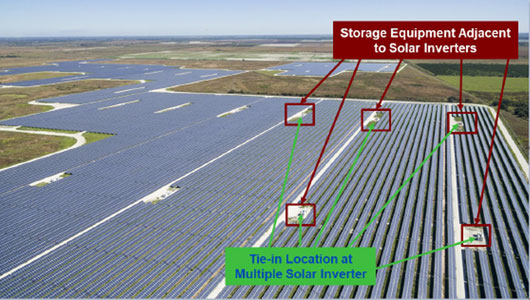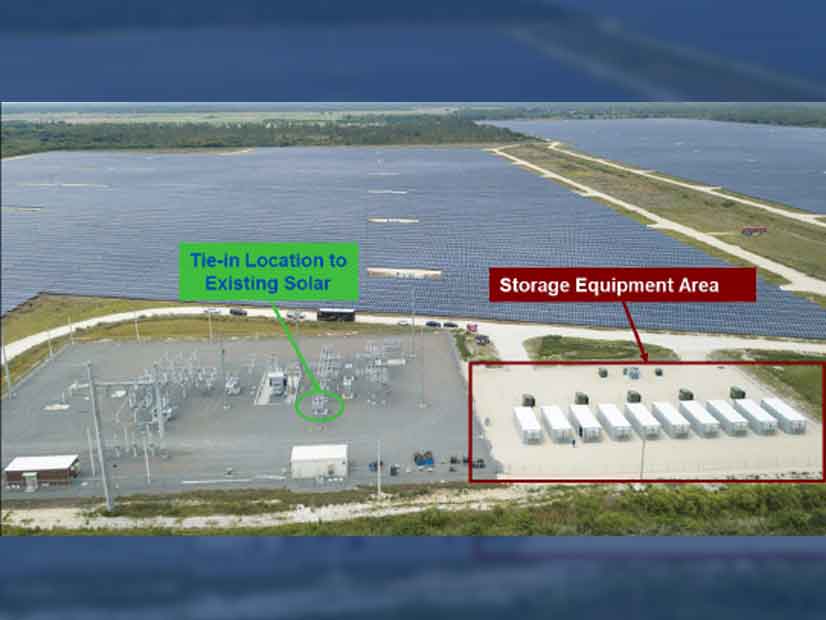Continue reading "NERC Tries to Stay Ahead of the Curve on Batteries, Hybrids"
Interconnection queues across the country are bursting with requests from battery energy storage systems (BESS) and hybrid power plants pairing storage with solar or wind. Because of their growing numbers and the differences in their operating characteristics from traditional synchronous generation, NERC issued a reliability guideline in March on the resources’ performance capabilities and how planners should model them in interconnection and planning studies.

Last week, the Inverter-Based Resource Performance Working Group (IRPWG) held an informational webinar with transmission operators, equipment manufacturers and other experts to discuss the importance of the guideline’s recommendations and how to implement them.
Although NERC has been updating the requirements for synchronous generators to make them relevant to inverter-based generation, hybrids and BESS offer more capabilities, said NERC’s Ryan Quint, one of two coordinators of the IRPWG.
“Those things behave differently, and you need to make sure those models are accurate and that the studies are conducted appropriately,” Quint said. “We need to be more proactive in addressing modeling challenges that the industry is facing, particularly if the number of these resources increase.”
New Concern for System Planners
Battery storage has not been a concern of system planners until recently, as states have set storage goals to take advantage of falling prices and technology advancements. Of the approximately 450 GW of solar power in U.S. interconnection queues as of the end of 2020, about one-third was paired with storage, according to the Lawrence Berkeley National Laboratory.
No place in the U.S. has promoted storage more than California, where growing solar power penetration and increasing wildfire risks have led state officials to tap storage to provide grid resilience and flexibility. (See CAISO Readies for Storage Scale-up.)
The California Public Utilities Commission expects to have 55,000 MW of new storage in the state by 2045 after meeting its 2020 energy storage goal of 1,325 MW early. The Gateway Project in the San Diego Gas & Electric service territory includes a 250-MW BESS providing energy and ancillary services in the CAISO market. In December, Vistra (NYSE:VST) began commercial operation of its 300-MW/1,200-MWh BESS at its Moss Landing natural gas power plant in Monterey County, the largest storage system in the world. The company said it may expand to 1,500 MW/6,000 MWh “should market and economic conditions support it.”
ERCOT expects more than 1,600 MW of BESS in service by the end of this year, NERC said.

While early BESS were primarily installed for energy arbitrage and mitigating renewable resource variability, the current wave of storage is seeking to provide short-term energy and reliability services, such as “ramping and variability control, voltage and frequency regulation and operation in low short-circuit conditions,” NERC said in the guideline. “It is imperative to have clear guidance on how BESS and hybrid power plants should perform when connected to the BPS [bulk power system] and also to have recommended practices for modeling and studying BESS and hybrid power plants for power flow, stability, short-circuit and electromagnetic transient (EMT) studies.”
NERC issued a 2018 reliability guideline on the recommended performance of BPS-connected inverter-based resources that included references to BESS, and a 2019 guideline recommending all transmission owners, transmission planners (TPs) and planning coordinators (PCs) improve their interconnection requirements and planning processes for new IBRs.
But the organization said “there are certain considerations and nuances to the operation of this technology that warrant additional guidance.”
“The recommendations in this guideline should apply to all BPS-connected BESS and hybrid plants and should not be limited only to bulk electric system (BES) facilities. Many newly interconnecting BESS projects and hybrid plants may not meet the BES definition; however, having unified performance and behavior from all BPS-connected inverter-based resources (including BESS and hybrid plants) is important for reliable operation of the North American BPS,” NERC said.
Recommendations
The guideline — which is applicable to TOs, TPs, PCs, balancing authorities, reliability coordinators, generator owners (GOs), generator operators (GOPs), developers and equipment manufacturers — make eight high-level recommendations, including:
- Interconnection Requirements and Processes: TOs’ interconnection requirements should be “clear and consistent for BESS and hybrid power plants.” TPs and PCs should provide clear modeling requirements and ensure that their study processes consider the unique operational capabilities of those facilities.
- Applicable entities should fully utilize the operational capabilities of BESS and hybrids to support reliability. “Capabilities like grid-forming technology, operation in low short-circuit networks, the ability to provide primary and fast frequency response and other functions more readily available in these new technologies should be fully utilized (as needed) and are essential reliability services for the BPS.”
- BESS and hybrid plant GOs should coordinate with developers and equipment manufacturers to “ensure that the models used to represent BESS and hybrid power plants accurately represent the controls, settings and performance of the equipment installed in the field.” This requires “rigorous verification and testing by the TP and PC.”
- Software Enhancements: Standardized library models do not capture the capabilities of BESS and hybrid plant controls. “Simulation software vendors should work with BESS and hybrid plant inverter and plant-level controller manufacturers to develop more flexible dynamic models to represent these facilities.” Software vendors should support use of “real-code” models — which implement the actual control code in the turbine controls, inverter controls, protection and measurement algorithms and plant-level controller — or other user-defined models “in a manner that does not degrade or limit the quality and fidelity of the overall interconnection-wide base case.”
- Study Process Enhancements: TPs and PCs should improve their interconnection study and annual planning study processes to ensure they capture the increase of BESS and hybrid power plants, including the determination of stressed operating conditions, selection of study assumptions, inclusion of modeling practices and determination of appropriate dispatch conditions.
- Expansion of Study Conditions: Although BESS and hybrid plants may help address some of the operational variability of renewables, “TPs and PCs may need to expand the set of study conditions used for future planning assessments as the most severe operating conditions may change over time.”
TOs should incorporate the recommended performance characteristics into their interconnection requirements per NERC FAC-001, according to the guideline; TPs and PCs are urged to incorporate the modeling and study recommendations into their interconnection processes under NERC FAC-002. NERC said entities should use the new guideline until the Institute of Electrical and Electronics Engineers’ P2800 project (Draft Standard for Interconnection and Interoperability of Inverter-Based Resources Interconnecting with Associated Transmission Electric Power Systems) is approved and fully implemented. IEEE’s Standards Association approved draft 6 of the standard with 84% support earlier this year.
Webinar Highlights
The webinar included a discussion of the difference between “grid-following” BESS — which require an external source to provide a reference voltage for locking the inverter phase — and grid-forming resources, which can operate in very low short-circuit strength networks and provide more support to the BPS.
Grid-following resources can be used to shift renewable generation to periods of high demand and provide grid stability through sub-second smart inverter responses. Grid-forming inverters can serve as black start resources.
“We probably don’t need every resource to be grid-forming in order to provide stability to the system,” said NERC’s Rich Bauer, another IRPWG coordinator. “However, if resources can implement grid-forming with not a lot of added cost, then it might be just a really good feature to have kind of as a standard product.”
Rachana Vidhi, a project director with NextEra Energy (NYSE:NEE), which has integrated battery storage into several existing wind and solar facilities, contrasted the difficulty of adding storage to AC- and DC-coupled renewables.
Adding storage to existing DC-coupled solar can be complicated because it requires space for the batteries adjacent to each solar inverter, Vidhi said. AC-coupled integration is simpler because the storage equipment can be placed adjacent to the solar collection substation, with little impact on solar operations. “This makes it a very easy retrofit to an existing solar plant,” she said.
Brad Marszalkowski, a senior engineer with ISO-NE, said batteries should be able to support system events regardless of their dispatch state.
“They should be able to respond to frequency and voltage excursions regardless of whether they’re in the charging or discharging mode at the time of the excursion. The same with providing dynamic voltage control during a transient. It’s also important that they have the capability to inject reactive power at zero active power. You can imagine a scenario where the battery is participating in, say, a regulation market and they’re [ready to respond to] frequency excursions. But they’re still connected to the system, so they can still have a voltage impact at that level. So if a voltage excursion happens — say there’s a fault or some other issue — they should still be able to respond to that.”
NERC’s Quint said BESS and hybrid plant owners should adopt those guideline’s recommendations into existing plants and new facilities where possible. “Some existing facilities that may have older technology may not be able to do some of the things we’ve highlighted in the recommendations, and that’s generally acceptable.”
For “new facilities, we really want to leverage these technologies and capabilities and make sure we’re utilizing them. All of that requires really close coordination with the GO, working with the transmission owner and balancing authority, reliability coordinators, transmission planners and planning coordinators. All those entities need to have an understanding of the operational capabilities and the limitations of the facility and how that thing is going to operate.”
“The developers need to work closely with the equipment manufacturers,” he added. “Almost all the [original equipment manufacturers] are actively involved in the IRPWG, so there’s a really clear, solid community here.”
Siddharth Pant, senior engineering manager for GE Power Conversion (NYSE:GE), noted that BESS and renewable resources have distinct limitations and capabilities. “Really the coordination of these different resource types is what makes it into a hybrid plant. Wind behaves quite differently than solar, and BESS is closer to solar but has even faster response times. All those have to be coordinated,” he said. “The parting message here is, please discuss with your manufacturers and developers: We have a solution for the problems that you’re facing.”




